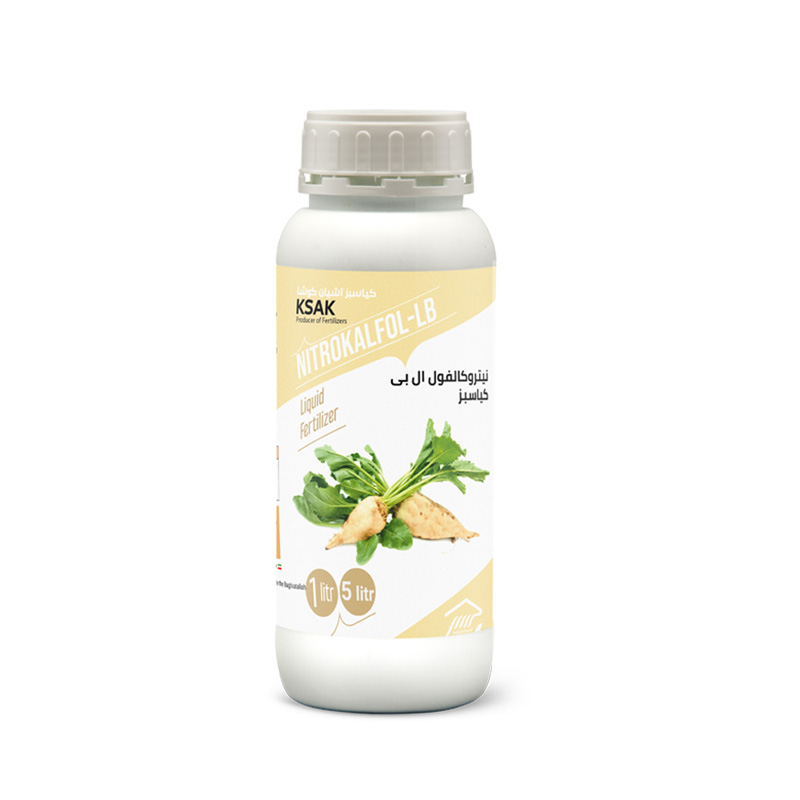
1400/11/29
Nitrokalfol - LB
NPK ( 8 - 4 - 12 ) + TE
Sugar beet is a biennial plant of the genus Spinach that is cultivated as an annual. Beet is economically influenced by two factors: quantity (tuber weight) and quality (sugar grade). Gland weight and sugar content in sugar beet plant are influenced by environmental conditions, genetics and nutritional factors. Important nutrients in beet cultivation are potassium, nitrogen, magnesium, phosphorus, boron, as well as trace elements, respectively. Potassium in the sugaring process, nitrogen in vegetative growth, magnesium in chloroplast formation and photosynthesis, phosphorus are effective in increasing tuber weight and boron in sugar transfer and increasing sugar content. One of the most important points about fertilizing sugar beet is the correct use of nitrogen fertilizers. Some farmers use nitrogen fertilizers until the last days before harvest, which, although it increases the vegetative growth of the shoots, but significantly reduces the weight of the tubers and especially the percentage of sugar. Therefore, in order to produce high quality and quantity products, it is necessary that fertilizers containing high nitrogen at the beginning of the growing season and fertilizers containing high potassium after the formation of tubers should be used. Boron also plays a very important role in the transfer of sugar from the shoots of sugar beet to its tubers, and it is necessary that in the late stages of beet growth, in order to transfer the sugars produced in beets to the tubers and increase their sugar content, fertilizers containing boron to be used.
Stages of growth of sugar beet:
One month before harvest |
After gland formation |
Before the formation of the gland |
Four leaves |
Germination |
Recommended table for feeding sugar beet:
Growth stage |
Fertilizer |
Application Dosage |
Application Method |
| The first irrigation | Liquid / powder humifol | 6-4 liters / 2-1 kg | Fertigation |
| Germination | Potassium nitrate | 10-7 kg | Fertigation |
| Four leaves stage | Equfol | 10-7 kg | Fertigation |
| Nitrokalfol - LB | 4-3 liters | Foliar Spray | |
| Liquid / powder humifol | 6-4 liters / 2-1 kg | Fertigation | |
| Before the formation of the gland | Phosphofol | 10-7 kg | Fertigation |
| After gland formation | Liquid / powder humifol | 6-4 liters / 2-1 kg | Fertigation |
| Kalfol | 10-7 kg | Fertigation | |
| Soloptas | 10-7 kg | Fertigation | |
| Nitrokalfol - LB | 4-3 liters | Foliar Spray | |
| One month before harvest | Borfol | 2-1 liters | Foliar Spray |
Recommended liquid beet fertilizer compositions:
the amount of (%) |
Amount (ppm) |
|||||||
| Nitrogen | Phosphorus | Potassium | Magnesium | Iron | Zinc | Copper | Manganese | Boron |
Characteristics of the proposed liquid beet fertilizer:
| Gland weight gain | Increase performance | Increase the percentage of sugar | Micronutrients in the form of chelates |
Notes:
- Foliar application should be sprayed in the cooler morning or evening hours.
- It should be performed a jar test to determine the compatibility of the present fertilizer with other fertilizers and pesticides before mixing and it can be used widely after confidence the physical compatibility in a small area of the farm.

